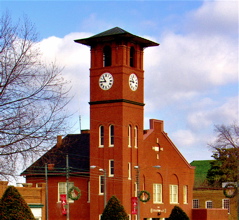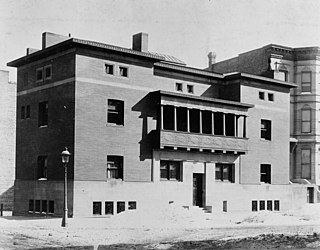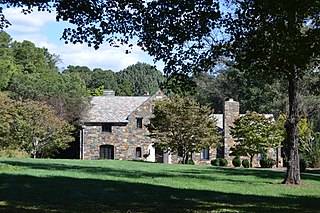
Henderson, a city with a population of 15,368 at the 2010 census, is the county seat of Vance County, North Carolina, United States.

William Alexander Graham was a United States Senator from North Carolina from 1840 to 1843, a Senator later in the Confederate States Senate from 1864 to 1865, the 30th Governor of North Carolina from 1845 to 1849 and U.S. Secretary of the Navy from 1850 to 1852, under President Millard Fillmore. He was the Whig Party nominee for vice-president in 1852 on a ticket with General Winfield Scott.

William Richardson Davie was a military officer and the 10th Governor of North Carolina from 1798 to 1799, as well as one of the most important men involved in the founding of the University of North Carolina. He was a member of the Federalist Party and served as a delegate to the Constitutional Convention as a representative of the state of North Carolina. He is a "Founding Father of the United States".

Pinnacle is an unincorporated community and census-designated place in southwestern Stokes County, North Carolina, United States, approximately 5 miles (8.0 km) SSE of the town of Pilot Mountain, between Pilot Mountain State Park and Hanging Rock State Park. As of March 2015, the exact population is 855.

The North Carolina State Capitol is the former seat of the legislature of the U.S. state of North Carolina which housed all of the state's government until 1888. The Supreme Court and State Library moved into a separate building in 1888, and the General Assembly moved into the State Legislative Building in 1963. Today, the governor and his immediate staff occupy offices on the first floor of the Capitol.

The James Charnley Residence, also known as the Charnley-Persky House, is a historic house museum at 1365 North Astor Street in the Gold Coast neighborhood of Chicago, Illinois. Built in 1892, it is one of the few surviving residential works of Louis Sullivan.

The Alice Freeman Palmer Memorial Institute, better known as Palmer Memorial Institute, was a school for upper class African Americans. It was founded in 1902 by Dr. Charlotte Hawkins Brown at Sedalia, North Carolina near Greensboro. Palmer Memorial Institute was named after Alice Freeman Palmer, former president of Wellesley College and benefactor of Dr. Brown.
This is an incomplete list of historic properties and districts at United States colleges and universities that are listed on the National Register of Historic Places (NRHP). This includes National Historic Landmarks (NHLs) and other National Register of Historic Places listings. It includes listings at current and former educational institutions.

Bentonville Battlefield is a North Carolina state historic site at 5466 Harper House Road in Johnston County, North Carolina. It belongs to the North Carolina Department of Natural and Cultural Resources and is the site of the 1865 Battle of Bentonville, fought in the waning days of the American Civil War. It was declared a National Historic Landmark in 1996.

W.T. Blackwell & Co. Tobacco was a tobacco manufacturer in Durham, North Carolina. It was best known as the original producer of Bull Durham Tobacco, the first nationally marketed brand of tobacco products in the United States. The Blackwell tobacco factory in Durham, built in 1874, was declared a National Historic Landmark in 1977. It is included in the American Tobacco Company Manufacturing Plant historic district, and is now occupied by apartments.

Christ Episcopal Church, also known as Christ Church on Capitol Square, is an Episcopal church at 120 East Edenton Street in Raleigh, North Carolina. Built in 1848–53 to a design by Richard Upjohn, it is one of the first Gothic Revival churches in the American South. The church was built for a parish established in 1821; its minister is the Rev. James P. Adams. It was declared a National Historic Landmark in 1987.

Falls, is an unincorporated community in Wake County, North Carolina, United States, situated on Old Falls of Neuse Road, between Raleigh and Wake Forest, near the Wakefield Plantation development. Falls Dam, on the Neuse River, is within the community.

Hope Plantation, built in 1803, is an early house built in the Palladian mode of the federal style, located on the Carolina Coastal Plain, near Windsor, North Carolina, in the United States. The plantation house was built by David Stone, a member of the coastal Carolina planter class, later Governor of North Carolina and a United States Senator. One of the finest examples of Palladian design built in timber, the manor house is slightly modified by neo-classical elements. The facade has five bays and a pedimented double portico with the original Chinese Chippendale balustrade. Crowning the house is a widow's walk with matching railing. The interior of the house displays a height and grandeur rare in the region, and is furnished with a unique collection of period furniture, art and artifacts.

Blackwell Island Lighthouse, now known as Roosevelt Island Lighthouse, also was known as Welfare Island Lighthouse, is a stone lighthouse built by the government of New York City in 1872. It is within Lighthouse Park at the northern tip of Roosevelt Island in the East River. It was named to the National Register of Historic Places on March 16, 1972 and was designated a New York City Landmark on March 23, 1976.

The William R. Davie House, on Norman St. in Halifax, Halifax County, North Carolina, is a historic house with significance dating from 1783. William R. Davie (1754–1820) was born in England. He was an patriot officer of mounted troops in the American Revolution, attended the Constitutional Convention from North Carolina, served as governor of North Carolina, served as a special ambassador to France during the XYZ Affair, and served in the North Carolina legislature. The house, also known as Loretta, was built on five acres that Davie bought in 1783. It was built starting probably in about 1785. It is a large two-story, frame side-hall plan house beneath a gable roof. It has a two-story wing raised from an earlier one-story wing and a number of one-story rear additions. The house is sheathed in weatherboard and rests on a brick foundation.

James Monroe Thompson House, also known as Shady Rest, is a historic home located near Saxapahaw, Alamance County, North Carolina. The original one-story, single-pen, log house was built about 1850. In 1872, a two-story log addition was built, and the original building used as a kitchen. The log house is sheathed in weatherboard and sits on a stone foundation.

Mary Duke Biddle Estate, also known as the James O. Cobb House, is a historic home and estate located at Durham, Durham County, North Carolina. The main house "Pinecrest" is a Tudor Revival style dwelling built in 1927, with additions and interior renovations made between 1935 and 1958. These additions and renovations included Colonial Revival, French Eclectic, Oriental, Art Moderne, and Art Deco elements. The estate property includes an additional three contributing outbuildings and nine contributing structures. They are The Cottage, a gasoline pump, iron picket fence with two ornamental gates, two large brick arches, stone-lined grottoes, bathhouse, tennis court, a swimming pool, a stone fireplace, pergola, a gardener's cottage with an attached greenhouse, and a storage garage. The estate was the home of philanthropist Mary Duke Biddle from 1935 until her death in 1960.

James B. and Diana M. Dyer House is a historic home located at Winston-Salem, Forsyth County, North Carolina. It was built in 1931, and is a large one- and two-story, irregularly-massed, Tudor Revival style dwelling with a rough-cut-stone exterior. It has a green slate roof, stepped stone chimney, and metal casement windows. It was built for James Dyer, a top executive at R. J. Reynolds Tobacco Company.

Fairfield Historic District is a national historic district located at Fairfield, Hyde County, North Carolina. The district encompasses 54 contributing buildings, 1 contributing site, and 1 contributing structure in the village of Fairfield. The district includes notable examples of Italianate and Carpenter Gothic style architecture dating to the last half of the 19th century. Notable buildings include the Blackwell-Carter-Midyette House (1850s), Dr. Patrick Simmons House (1871), Carter~Holton-Sears House, Fairfield Methodist Episcopal Church (1877), E. S. O'Neal And Sons Store, Calhoun Brown Store, Fairfield Cemetery Pavilion, and Carter-Swindell House (1870s).

The Bollinger-Hartley House is a historic house located at 423 North Main Street in Blowing Rock, Watauga County, North Carolina.


















